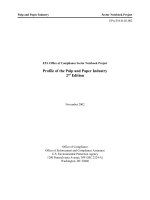smith functional safety 2nd edition 2004
Bạn đang xem bản rút gọn của tài liệu. Xem và tải ngay bản đầy đủ của tài liệu tại đây (1.28 MB, 276 trang )
Functional Safety
A Straightforward Guide to applying IEC 61508 and
Related Standards
Prelims.qxd 5/22/04 10:00 Page i
This page intentionally left blank
Functional Safety
A Straightforward Guide to applying
IEC 61508 and Related Standards
Second edition
David J Smith
BSc, PhD, CEng, FIEE, FIQA, HonFSaRS, MIGasE
Kenneth G L Simpson
MPhil, FIEE, FInstMC, MIGasE
AMSTERDAM
•
BOSTON
•
HEIDELBERG
•
LONDON
•
NEW YORK
•
OXFORD
PARIS
•
SAN DIEGO
•
SAN FRANCISCO
•
SINGAPORE
•
SYDNEY
•
TOKYO
Prelims.qxd 5/22/04 10:00 Page iii
Elsevier Butterworth-Heinemann
Linacre House, Jordan Hill, Oxford OX2 8DP
200 Wheeler Road, Burlington, MA 01803
First published 2001
Second edition 2004
Copyright © 2001, 2004, David J Smith and Kenneth G L Simpson
All rights reserved.
The right of David J Smith and Kenneth G L Simpson to be identified as the
authors of this work has been asserted in accordance with the Copyright,
Designs and Patents Act 1988
No part of this publication may be reproduced in any material form (including
photocopying or storing in any medium by electronic means and whether or not
transiently or incidentally to some other use of this publication) without the
written permission of the copyright holder except in accordance with the
provisions of the Copyright, Designs and Patents Act 1988 or under the terms
of a licence issued by the Copyright Licensing Agency Ltd, 90 Tottenham Court
Road, London, England W1T 4LP. Applications for the copyright holder’s written
permission to reproduce any part of this publication should be addressed to the
publisher
Permissions may be sought directly from Elsevier’s Science & Technology Rights
Department in Oxford, UK: phone: (ϩ44) 1865 843830, fax: (ϩ44) 1865 853333,
e-mail: You may also complete your request on-line
via the Elsevier homepage (), by selecting ‘Customer
Support’ and then ‘Obtaining Permissions’
British Library Cataloguing in Publication Data
A catalogue record for this book is available from the British Library
Library of Congress Cataloguing in Publication Data
A catalogue record for this book is available from the Library of Congress
ISBN 0 7506 6269 7
For information on all Elsevier Butterworth-Heinemann publications visit our
website at
Printed and bound in Great Britain
Prelims.qxd 5/22/04 10:00 Page iv
Contents
A Quick Overview ix
Acknowledgements xi
Part A The Concept of Safety-Integrity
1 The meaning and context of Safety-Integrity targets 3
1.1 Risk and the need for safety targets 3
1.2 Quantitative and qualitative safety targets 7
1.3 The life-cycle approach 11
1.4 Basic steps in the assessment process 14
1.5 Costs 16
1.6 The seven parts of IEC 61508 17
Part B The Basic Requirements of IEC 61508 and 61511
2 Meeting IEC 61508 Part 1 25
2.1 Functional safety management and competence 25
2.2 Establishing SIL targets 30
2.3 Applying ALARP 38
3 Meeting IEC 61508 Part 2 42
3.1 Organising and managing the life-cycle 43
3.2 Requirements involving the specification 44
3.3 Requirements for design and development 46
3.4 Integration and test 52
3.5 Operations and maintenance 52
3.6 Validation 53
3.7 Modifications 53
3.8 Acquired sub-systems 54
3.9 ‘Proven in use’ 54
3.10 Presenting the results 55
Conformance Demonstration Template 55
Prelims.qxd 5/22/04 10:00 Page v
4 Meeting IEC 61508 Part 3 61
4.1 Organising and managing the software engineering 62
4.2 Requirements involving the specification 65
4.3 Requirements for design and development 65
4.4 Integration and test 67
4.5 Validation 68
4.6 Modifications 69
4.7 Some technical comments 69
4.8 ‘Proven in use’ 73
4.9 Presenting the results 74
Conformance Demonstration Template 74
5 Meeting IEC 61511 80
5.1 Organising and managing the life-cycle 81
5.2 Requirements involving the specification 83
5.3 Requirements for design and development 84
5.4 Integration and test 87
5.5 Validation 88
5.6 Modifications 88
5.7 Installation and commissioning 88
5.8 Operations and maintenance 89
5.9 Presenting the results 89
Part C The Quantitative Assessment
6 Reliability modelling techniques 93
6.1 Failure rate and unavailability 93
6.2 Creating a reliability model 94
6.3 Taking account of auto-test 104
6.4 Human error/human factors 107
7 Failure rate and mode data 112
7.1 Data accuracy 112
7.2 Sources of data 115
7.3 Data ranges and confidence levels 118
7.4 Conclusions 120
Part D Related Issues
8 Some comments on Part 6 of IEC 61508 125
8.1 Overview 125
8.2 The quantitative tables (Annex B) 126
8.3 The software safety-integrity tables (Annex E) 131
9 Second tier and related guidance documents 132
9.1 IEC 61511 (Process) 132
Contentsvi
Prelims.qxd 5/22/04 10:00 Page vi
9.2 IGEM SR/15 133
9.3 UKOOA (Offshore) 133
9.4 ISA S84.01 (Instrumentation) 136
9.5 OLF-077 (Norwegian) 137
9.6 EN 50126 (Railways) 137
9.7 UK MOD (Defence) 140
9.8 MISRA guidelines (Motor) 142
9.9 MISRA C Code guidelines 142
9.10 IEC 61513 (Nuclear) 143
9.11 EEMUA guidelines 145
9.12 RTCA DO-178B (Civil air) 146
9.13 DIN V Standards 146
9.14 Documents related to machinery 147
9.15 NPL Software guidelines 148
9.16 SEMSPLC (Programmable controllers) 149
9.17 Q124 Demonstration guidelines 150
10 Demonstrating and certifying conformance 151
10.1 Demonstrating conformance 151
10.2 The current framework for certification 152
10.3 Self-certification 154
10.4 Other types of ‘certification’ 157
10.5 Preparing for assessment 158
10.6 Summary 159
Part E Case Studies in the Form of Exercises and Examples
11 Pressure control system (exercise) 163
12 Burner control assessment (example) 171
13 SIL targeting – some practical examples 189
14 Hypothetical rail train braking system (example) 198
Appendix 1 Functional safety capability – template
procedure 211
Appendix 2 Assessment schedule (checklist) 230
Appendix 3 Betaplus CCF model, checklists 235
Appendix 4 Assessing safe failure fraction and
diagnostic coverage 240
Appendix 5 Answers to examples 245
Appendix 6 References 252
Appendix 7 ‘High and low demand’ 255
Appendix 8 Some terms and jargon of IEC 61508 257
Index 261
Contents vii
Prelims.qxd 5/22/04 10:00 Page vii
61508
Process
oil and gas
IEC
61511
UKOOA
IGEM
SR\15
ISA
S84.01
OLF
O77
Rail
EN 50126
EN 50128 EN 50129
Defence
DEF STAN
00–56
(00–54,
00–55, 00–58
superseded)
MISRA
guidelines
MISRA
C Standard
Auto-
motive
Miscellaneous
EEMUA
guidelines
IEC
61513
nuclear
DIN
standards
DO 178B
air
Machinery
standards
IEC
62061
machinery
NPL
software
guidelines
Q124
Assessment
guidelines
IEE
SEMSPLC
withdrawn
Other
Prelims.qxd 5/22/04 10:00 Page viii
A QUICK OVERVIEW
Functional safety involves identifying specific hazardous fail-
ures which lead to serious consequences (e.g. death) and then
establishing maximum tolerable frequency targets for each
mode of failure. Equipment whose failure contributes to each
of these hazards is identified and usually referred to as ‘safety-
related’. Examples are industrial process control systems,process
shutdown systems, rail signalling equipment, auto-motive con-
trols, medical treatment equipment etc. In other words, any
equipment (with or without software) whose failure can con-
tribute to a hazard is likely to be safety-related.
Since the publication of the first edition of this book, in 2001,
the application of IEC 61508 has spread rapidly through most
sectors of industry.Also, the process sector IEC 61511 has been
published. The opportunity has therefore been taken to update
and enhance this book in the light of the authors’ recent expe-
rience. Chapter 5 is now devoted to IEC 61511 and Chapters 13
and 14 have been added to provide even more examples.
The maximum tolerable failure rate for each hazard will
lead us to an integrity target for each piece of equipment,
depending upon its relative contribution to the hazard in ques-
tion. These integrity targets are known as ‘safety-integrity
levels’ and are usually described by one of four discrete bands
described in Chapter 1.
SIL 4: the highest target and most onerous to achieve,
requiring state of the art techniques (usually avoided)
SIL 3: less onerous than SIL 4 but still requiring the use of
sophisticated design techniques
Prelims.qxd 5/22/04 10:00 Page ix
A Quick Overviewx
SIL 2: requiring good design and operating practice to a
level not unlike ISO 9000
SIL 1: the minimum level but still implying good design
practice
ϽSIL 1: referred to (in IEC 61508 and other documents) as
‘not-safety related’ in terms of compliance
An assessment of the design, the designer’s organisation and
management, the operator’s and the maintainer’s competence
and training should then be carried out in order to determine
if the proposed (or existing) equipment actually meets the tar-
get SIL in question. The steps involve:
Setting the SIL targets Chapter 2.2
Capability to design for functional safety Chapter 2.1
Quantitative assessment Chapters 3, 5, 6 & 7
Qualitative assessment Chapters 3, 4 & 5
Establishing competency Chapter 2.1
As low as reasonably practicable Chapter 2.3
Reviewing the assessment itself Appendix 2
IEC 61508 is a generic standard which deals with the above. It
can be used on its own or as a basis for developing industry
sector specific standards (Chapter 9). In attempting to fill the
roles of being both a global template for the development of
application specific standards, and being a standard in its own
right, it necessarily leaves much to the discretion and interpret-
ation of the user. Plans to revise it are well under way and a
draft is planned for June 2004 with a target of 2006 for finalisa-
tion. It is now a BS EN document.
It is vital to bear in mind, however, that no amount of assess-
ment will lead to enhanced integrity unless the assessment
process is used as a tool during the design-cycle.
NOW READ ON!
Prelims.qxd 5/22/04 10:00 Page x
ACKNOWLEDGEMENTS
The authors are very grateful to Mike Dodson, Independent
Consultant, of Solihull, for extensive comments and suggestions
and for a thorough reading of the manuscript:
We are also grateful to Colin Sellers of AEA Technology
Rail for inputs concerning rail related standards and UKOOA
(United Kingdom Offshore Operators Association) for per-
mission to reproduce the risk graph.
Thanks are also due to Graham Ottley of Silveretch Inter-
national for many comments.
Thanks also to Mr Roger Stillman of SIRA Certification
Services and to Dr Brian Wichmann for comments on the
original proposals and to Dr Tony Foord for assistance with
Chapter 14.
Prelims.qxd 5/22/04 10:00 Page xi
This page intentionally left blank
PART
A
THE C
ONCEPT OF
SAFETY-INTEGRITY
In this first chapter we will introduce the concept of functional
safety, expressed in terms of safety integrity levels. It will be
placed in context, along with risk assessment, likelihood of
fatality and the cost of conformance.
The life-cycle approach, together with the basic outline of
IEC 61508, will be explained.
Chap-01.qxd 5/22/04 9:52 Page 1
This page intentionally left blank
CHAPTER
1
THE MEANING AND CONTEXT OF
SAFETY
-INTEGRITY TARGETS
1.1 Risk and the need for safety targets
There is no such thing as zero risk. This is because no physical
item has a zero failure rate, no human being makes zero errors
and no piece of software design can foresee every possibility.
Nevertheless public perception of risk, particularly in the
aftermath of a major incident, often calls for the zero risk
ideal. However, in general most people understand that this is
not practicable as can be seen from the following examples of
everyday risk of death from various causes:
All causes (mid-life including medical) 1 ϫ 10
Ϫ3
pa
All accidents (per individual) 5 ϫ 10
Ϫ4
pa
Accident in the home 4 ϫ 10
Ϫ4
pa
Road traffic accident 6 ϫ 10
Ϫ5
pa
Natural disasters (per individual) 2 ϫ 10
Ϫ6
pa
Therefore the concept of defining and accepting a tolerable
risk for any particular activity prevails.
The actual degree of risk considered to be tolerable will vary
according to a number of factors such as the degree of control
one has over the circumstances, the voluntary or involuntary
nature of the risk, the number of persons at risk in any one
incident and so on. This partly explains why the home remains
one of the highest areas of risk to the individual in everyday
life since it is there that we have control over what we choose
to do and are therefore prepared to tolerate the risks involved.
Chap-01.qxd 5/22/04 9:52 Page 3
Functional Safety 1.1
A safety technology has grown up around the need to set
target risk levels and to evaluate whether proposed designs
meet these targets be they process plant, transport systems,
medical equipment or any other application.
In the early 1970s people in the process industries became
aware that, with larger plants involving higher inventories of haz-
ardous material, the practice of learning by mistakes (if indeed
we do) was no longer acceptable. Methods were developed for
identifying hazards and for quantifying the consequences of fail-
ures. They were evolved largely to assist in the decision-making
process when developing or modifying plant. External pressures
to identify and quantify risk were to come later.
By the mid-1970s there was already concern over the lack of
formal controls for regulating those activities which could lead
to incidents having a major impact on the health and safety of
the general public. The Flixborough incident in June 1974,
which resulted in 28 deaths, focused UK public and media
attention on this area of technology. Many further events, such
as that at Seveso (Italy) in 1976 through to the Piper Alpha off-
shore disaster and more recent Paddington (and other) rail
incidents, have kept that interest alive and have given rise to
the publication of guidance and also to legislation in the UK.
The techniques for quantifying the predicted frequency of
failures are just the same as those previously applied to plant
availability, where the cost of equipment failure was the prime
concern. The tendency in the last few years has been for more
rigorous application of these techniques (together with third
party verification) in the field of hazard assessment. They
include Fault Tree Analysis, Failure Mode and Effect Analysis,
Common Cause Failure Assessment and so on. These will be
addressed in Chapters 6 and 7.
Hazard assessment of process plant, and of other industrial
activities, was common in the 1980s but formal guidance and
standards were rare and somewhat fragmented. Only Section 6
of the Health and Safety at Work Act 1974 underpinned the
need to do all that is reasonably practicable to ensure safety.
However, following the Flixborough disaster, a series of moves
(including the Seveso directive) led to the CIMAH (Control
of Industrial Major Accident Hazards) regulations, 1984,
and their revised COMAH form (Control Of Major Accident
4
Chap-01.qxd 5/22/04 9:52 Page 4
Hazards) in 1999. The adoption of the Machinery Directive by
the EU, in 1989, brought the requirement for a documented
risk analysis in support of CE marking.
Nevertheless, these laws and requirements do not specify
how one should go about establishing a target tolerable risk
for an activity, nor do they address the methods of assessment
of proposed designs nor provide requirements for specific
safety-related features within design.
The need for more formal guidance has long been acknow-
ledged. Until the mid-1980s risk assessment techniques tended
to concentrate on quantifying the frequency and magnitude of
consequences of given risks. These were sometimes compared
with loosely defined target values but, being a controversial
topic, these targets (usually in the form of fatality rates) were
not readily owned up to or published.
EN 1050 (Principles of risk assessment), in 1996, covered the
processes involved in risk assessment but gave little advice on
risk reduction. For machinery control EN 954-1 (Safety related
parts of control systems) provided some guidance on how to
reduce risks associated with control systems but did not specif-
ically include PLCs (programmable logic controllers) which
were separately addressed by other IEC (International Electro-
technical Commission) and CENELEC (European Committee
for Standardisation) documents.
The proliferation of software during the 1980s, particularly
in real time control and safety systems, focused attention on
the need to address systematic failures since they could not
necessarily be quantified. In other words whilst hardware fail-
ure rates were seen as a credibly predictable measure of reli-
ability, software failure rates were generally agreed not to be
predictable. It became generally accepted that it was necessary
to consider qualitative defences against systematic failures as
an additional, and separate, activity to the task of predicting
the probability of so-called random hardware failures.
In 1989, the HSE (Health and Safety Executive) published
guidance which encouraged this dual approach of assuring
functional safety of programmable equipment. This led to IEC
work, during the 1990s, which culminated in the International
Safety Standard IEC 61508 – the main subject of this book.
The IEC Standard is concerned with electrical, electronic and
The meaning and context of Safety-Integrity targets 5
Chap-01.qxd 5/22/04 9:52 Page 5
programmable safety-related systems where failure will affect
people or the environment. It has a voluntary, rather than
legal, status in the UK but it has to be said that to ignore it
might now be seen as ‘not doing all that is reasonably practic-
able’ in the sense of the Health and Safety at Work Act and a
failure to show ‘due diligence’.As use of the Standard becomes
more and more widespread it can be argued that it is more and
more ‘practicable’ to use it. Figure 1.1 shows how IEC 61508
relates to some of the current legislation.
The purpose of this book is to explain, in as concise a way as
possible, the requirements of IEC 61508 and the other industry-
related documents (some of which are referred to as second
Functional Safety 1.16
Health and
Safety at
Work Act
1974
Seveso
directive
1976
CIMAH
1984
COMAH
1999
Machinery
directive
1989
Invokes
(indirectly)
Provides
supporting
evidence to
regulators
IEC 61508
Figure 1.1
Chap-01.qxd 5/22/04 9:52 Page 6
tier guidance) which translate the requirements into specific
application areas.
The Standard, as with most such documents, has consider-
able overlap, repetition, and some degree of ambiguity, which
places the onus on the user to make interpretations of the
guidance and, in the end, apply his/her own judgement.
The question frequently arises as to what is to be classified
as safety-related equipment. The term ‘safety-related’ applies
to any hardwired or programmable system where a failure,
singly or in combination with other failures/errors, could lead
to death, injury or environmental damage. The terms ‘safety-
related’ and ‘safety-critical’ are often used and the distinction
has become blurred. ‘Safety-critical’ has tended to be used
where failure alone, of the equipment in question, leads to a
fatality or increase in risk to exposed people. ‘Safety-related’
has a wider context in that it includes equipment in which a
single failure is not necessarily critical whereas coincident fail-
ure of some other item leads to the hazardous consequences.
A piece of equipment, or software, cannot be excluded from
this safety-related category merely by identifying that there
are alternative means of protection.This would be to pre-judge
the issue and a formal safety integrity assessment would still be
required to determine whether the overall degree of protec-
tion is adequate.
1.2 Quantitative and qualitative safety targets
In the previous section we introduced the idea of needing to
address safety-integrity targets in two ways:
Quantitatively: where we predict the frequency of hardware
failures and compare them with some tolerable risk target.
If the target is not satisfied then the design is adapted (e.g.
provision of more redundancy) until the target is met.
Qualitatively: where we attempt to minimise the occurrence
of systematic failures (e.g. software errors) by applying a
variety of defences and design disciplines appropriate to the
severity of the tolerable risk target.
The question arises as to how a safety-integrity target can
be expressed in such a way as to be consistent with both
The meaning and context of Safety-Integrity targets 7
Chap-01.qxd 5/22/04 9:52 Page 7
Note that had the high demand SIL bands been expressed as
‘per annum’ then the tables would appear numerically similar.
However, being different parameters, they are not even the
same dimensionally. Thus the ‘per hour’ units are used to min-
imise confusion.
The reason for there being effectively two tables (high and
low demand) is that there are two ways in which the integrity
target may need to be described. The difference can best be
understood by way of examples.
Consider the motor car brakes. It is the rate of failure which
is of concern because there is a high probability of suffering the
hazard immediately each failure occurs. Hence we have the
middle column of Table 1.1.
On the other hand, consider the motor car air bag. This is a
low demand protection system in the sense that demands on it
are infrequent (years or tens of years apart). Failure rate alone
is of little use to describe the integrity since the hazard is not
incurred immediately each failure occurs and we therefore
have to take into consideration the test interval. In other
words, since the demand is infrequent, failures may well be
Functional Safety 1.28
Table 1.1 Safety-Integrity Levels (SILs)
Safety-Integrity Level High demand rate Low demand rate
(Dangerous failures/hr) (Probability of failure on
demand)
4 у10
Ϫ9
to Ͻ10
Ϫ8
у10
Ϫ5
to Ͻ10
Ϫ4
3 у10
Ϫ8
to Ͻ10
Ϫ7
у10
Ϫ4
to Ͻ10
Ϫ3
2 у10
Ϫ7
to Ͻ10
Ϫ6
у10
Ϫ3
to Ͻ10
Ϫ2
1 у10
Ϫ6
to Ͻ10
Ϫ5
у10
Ϫ2
to Ͻ10
Ϫ1
approaches. During the 1990s the concept of safety-integrity
levels (known as SILs) evolved and is used in the majority of
documents in this area. The concept is to divide the ‘spectrum’
of integrity into a number of discrete levels (usually four) and
then to lay down requirements for each level. Clearly, the
higher the SIL then the more stringent become the require-
ments. In IEC 61508 (and in most other documents) the four
levels are defined in Table 1.1.
Chap-01.qxd 5/22/04 9:52 Page 8
dormant and persist during the test interval. What is of inter-
est is the combination of failure rate and down time and we
therefore specify the probability of failure on demand (PFD).
Hence the right-hand column of Table 1.1.
In IEC 61508 the high demand definition is called for when
the demand on a safety related function is greater than once
per annum and the low demand definition when it is less fre-
quent. There is some debate on this issue and it is believed
that the classification might change. One possibility is that
low demand might be defined as being when the demand
rate is much less than the test frequency (i.e. reciprocal of
the test interval).
In Chapter 2 we will explain the ways of establishing a target
SIL and it will be seen that the IEC 61508 Standard then
goes on to tackle the two areas of meeting the quantifiable
target and addressing the qualitative requirements separately.
Appendix 7 has more on the difference between the high and
low demand scenarios.
A frequent misunderstanding is to assume that if the
qualitative requirements of a particular SIL are observed the
numerical failure targets, given in Table 1.1, will automatically
be achieved. This is most certainly not the case since the
two issues are quite separate. The quantitative targets refer to
random hardware failures and are dealt with in Chapters 6–8.
The qualitative requirements refer to quite different failures
whose frequency is not quantified and are dealt with sep-
arately. The assumption, coarse as it is, is that by spreading the
rigour of requirements across the range SIL 1–SIL 4, which in
turn covers the credible range of achievable integrity, the
achieved integrity is likely to coincide with the measures
applied.
A question sometimes asked is:
If the quantitative target is met by the predicted random
hardware failure probability then what allocation should
there be for the systematic (software) failures? Note 1 of
7.4.2.2 of Part 2 of the Standard tells us that the target is to
be applied equally to random hardware failures and to sys-
tematic failures. In other words the numerical target is not
The meaning and context of Safety-Integrity targets 9
Chap-01.qxd 5/22/04 9:52 Page 9
divided between the two but applied to the random hard-
ware failures. The corresponding SIL requirements are then
applied to the systematic failures. In any case, having regard
to the accuracy of quantitative predictions (see Chapter 7),
the point may not be that important.
The following should be kept in mind:
SIL 1: is relatively easy to achieve especially if ISO 9001 prac-
tices apply throughout the design providing that Functional
Safety Capability is demonstrated (see Section 2.1).
SIL 2: is not dramatically harder than SIL 1 to achieve although
clearly involving more review and test and hence more cost.
Again, if ISO 9001 practices apply throughout the design, it
should not be difficult to achieve.
(SILs 1 and 2 are not dramatically different in terms of the
life-cycle activities)
SIL 3: however, involves a significantly more substantial incre-
ment of effort and competence than is the case from SIL 1 to
SIL 2. Specific examples are the need to revalidate the system
following change and the increased need for training of oper-
ators.Cost and time will be a significant factor and the choice of
vendors will be more limited by lack of ability to provide SIL 3
designs.
SIL 4: involves state of the art practices including ‘formal
methods’ in design. Cost will be extremely high and compe-
tence in all the techniques required is not easy to find. There
is a considerable body of opinion that SIL 4 should be avoided
and that additional levels of protection should be preferred.
It is reasonable to say that the main difference between the
SILs is the quantification of random hardware failures and
he application of the Safe Failure Fraction (see Chapter 3).
The qualitative requirements for SILs 1 and 2 are very similar,
as are those for SILs 3 and 4. The major difference occurs in
the step between SIL 2 and SIL 3.
Note, also, that as one moves up the SILs the statistical
implications of verification become more onerous whereas
the assessment becomes more subjective due to the limita-
tions of the data available for the demonstration.
Functional Safety 1.210
Chap-01.qxd 5/22/04 9:52 Page 10
1.3 The life-cycle approach
The various life-cycle activities and defences against system-
atic failures, necessary to achieve functional safety, occur at
different stages in the design and operating life of any equip-
ment. Hence it has long been considered a good idea to define
(that is to say describe) a life-cycle.
IEC 61508 describes itself as being based on a safety life-
cycle approach and therefore it describes such a model and
identifies activities and requirements based on it. It is import-
ant to understand this because a very large proportion of
safety assessment work has been (and often still is) confined to
assessing if the proposed design configuration (architecture)
meets the target failure probabilities (Part C of this book).
Most modern guidance (especially IEC 61508) requires a
much wider approach involving control over all of the life-
cycle activities that influence safety-integrity.
Figure 1.2 shows a simple life-cycle very similar to the one
shown in the Standard. It has been simplified for the purposes
of this book.
As far as IEC 61508 is concerned this life-cycle applies to all
electrical and programmable aspects of the safety-related equip-
ment.Therefore if a safety-related system contains an E/PE elem
ent then the Standard applies to all the elements of system,
including mechanical and pneumatic equipment. There is no rea-
son, however, why it should not also be used in respect of ‘other
technologies’ where they are used to provide risk reduction.
The IEC 61508 headings are summarised in the following
pages and also map to the descriptions of many of the headings
in Chapters 3, 4 and 5.This is because the Standard repeats the
process for systems hardware (Part 2) and for software (Part 3).
IEC 65108 Part 1 lists these and calls the list Table 1 with asso-
ciated paragraphs of text. In the following text ‘*’ refers to the
IEC 61508 Part 1 Table. Also, the IEC 61508 paragraph num-
bers for the associated text, in Parts 1, 2 and 3, are given:
Life-cycle (*1) [Part 1 – 7.1/2: Part 2 – 7.1/2: Part 3 – 7.1/2]
Sets out the life-cycle for the development maybe as per IEC
61508, or as shown in Figure 1.2 of this book, or some other
suitable format having regard to the project and to in-house
practice.
The meaning and context of Safety-Integrity targets 11
Chap-01.qxd 5/22/04 9:52 Page 11
Equipment Under Control (EUC) and scope (*2) [Part 1 – 7.3]
Defines exactly what is the system and the part(s) being con-
trolled. Understands the EUC boundary and its safety require-
ments. Scopes the hazards and risks by means of hazard
identification techniques (e.g. HAZOP). Requires a safety
plan for all the life-cycle activities.
Hazard and risk analysis (*3) [Part 1 – 7.4]
This involves the quantified risk assessment by considering the
consequences of failure (often referred to as HAZAN).
Safety requirements and allocation (*4/5) [Part 1 – 7.5/6:
Part 2 – 7.2: Part 3 – 7.2]
Here we address the whole system and set maximum tolerable
risk targets and allocate failure rate targets to the various failure
Functional Safety 1.312
Life-cycle and scope
Risk analysis
Safety requirements and
allocation
Planning
Installation and
commissioning
Safety validation
Operations and
maintenance
Install and commission
Validate
Design/procure/build
Safety-related
systems
Operations and
maintenance and
modifications
Decommissioning
Verify
Figure 1.2
Safety life-cycle
Chap-01.qxd 5/22/04 9:52 Page 12









